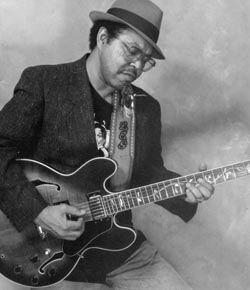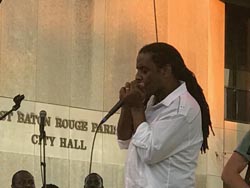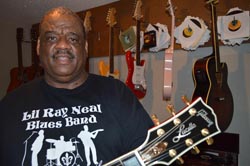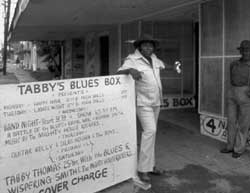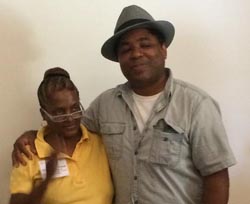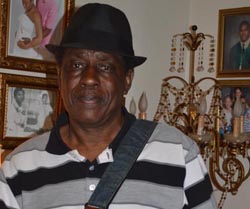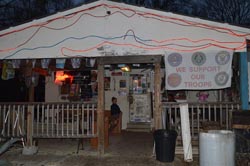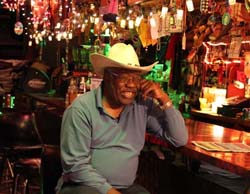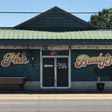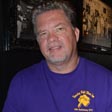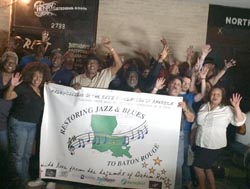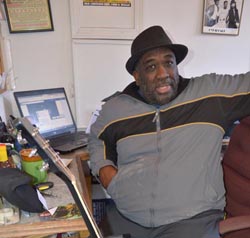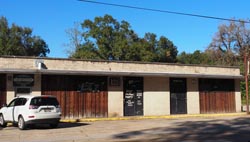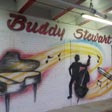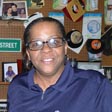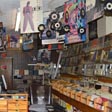Blues & Blacks in the Red Stick: Origins, Evolution, and Current Status
By Joyce Jackson
The blues was here before us and will be
here when we are long gone.—Silas Hogan
Blues is a secular African American music of the 20th century with a history that actually dates back to the Reconstruction era. It has taken many forms and, as an expressive folk and popular music, has a relatively short but complex history. Its development through the years reflects the cultural essence and changes within the Black community. Because of its perpetual presence in the lives of so many and its deep roots in the Black experience in America, the blues has an overarching influence on other musical genres. In Louisiana alone, not only has it influenced traditional jazz and early rhythm and blues, but also the southwestern Louisiana genre of zydeco.
The blues is still pervasive not only in the south, but in other areas where Blacks have migrated in large numbers around the country. Many bluesmen have just managed to get a short distance from their backyard family/friend jams while others have been on concert stages around the world many times. Blues is also performed by members of other ethnic groups and the audience has expanded tremendously through clubs, concerts, and festivals.
In this blues focused ethnographic research, I examine origin narratives, influences and evolution and the status of the blues in the Baton Rouge region today, according to accounts by practitioners. As I traced the influences which helped to shape the present-day Baton Rouge blues sound, or Swamp Blues sound as it is also referred to, I began to wonder if indeed there was a discernible Swamp Blues sound, or was it simply a convenient geographical term used by music journalists and record companies. I asked if there was no specific Baton Rouge blues sound, would it still be possible to trace the musical influences of the music, which is being played on the city's blues circuit today.
Through spending time in the blues venues which Baton Rouge offers and listening to recordings, I have come to the conclusion that, although the blues played in the city is certainly eclectic, that does not mean that there is not a swamp blues sound in there amongst all other blues styles. The swamp sound has a heavily rhythmic walking-bass derived from Chicago bluesman, Jimmy Reed. The drums are muffled, the harmonicas have a long, smooth sound, and the vocals are melodious. As Tabby Thomas describes it, "It's more musical than some blues." However, as I examined these performance practices and status of the blues in Baton Rouge today, I continue to wonder where the performance practices came from. First, in order to ascertain the present, we have to examine the past. What follows is a brief historical background on the region in terms of the cultural and migratory landscape.
Historical Background
While Afro-Americans in some other southern states such as Mississippi, Texas, and Georgia developed their own specific rural blues styles, there was no such parallel development of a specific style in Louisiana, despite the large Black population, except in the region around Baton Rouge. Part of the reason for this is the French-Caribbean origins of much of the Black population in Louisiana. Particularly in the New Orleans area, there were many free 'people of color' who were already aspiring to a white way of life. This, allied with the fact that Acadiana and the rest of south Louisiana had a large French population who tended to be more accepting than their English counterparts in the other southern states, contributed to the lack of development of blues music throughout south Louisiana during the first half of the 20th century. The solo bluesman accompanying himself on the guitar tended to be found only in Baton Rouge, and the surrounding farming communities of Zachary, Clinton, St. Francisville, and Slaughter. Blacks and Whites in New Orleans would enjoy jazz, and in Acadiana and the French country music—either Cajun or La-La and Creole folk songs would be celebrated by both Black and White communities.
It is true that Shreveport in north Louisiana gave the blues world a few early commercial recordings, most notably those of Huddie Leadbetter (Leadbelly). However, then, even more so than today, north and south Louisiana were culturally two separate entities. Until Huey P. Long developed communications throughout the 1930s, with hundreds of miles of new roads and 111 bridges, Louisiana was like three separate countries - north Louisiana, south Louisiana and New Orleans. However, the geographical and political boundaries of Louisiana have not been barriers of cultural influences.
East and South Louisiana are more culturally alike than north and south Louisiana, sharing similar tastes in music, dance, and food. Two of Louisiana's main roads, Highway 90, and the more recent, Interstate 10, run from south Texas across south Louisiana to Baton Rouge, New Orleans and beyond, reinforcing communication between Texas and south Louisiana. Until Huey Long opened up Louisiana, apart from the Mississippi port areas, the state was very much cut off from the outside world. The opening up of the state geographically, a healthier economic climate due to development of petroleum and chemical industries in Baton Rouge and Acadiana, and the increased trend for people to purchase radios conspired to create a new environment for the roots to develop of what was to become a new urban blues sound. The post-World War II years brought a feeling of local pride back to the area. Men who had been away from home for so long were now eager to hear local music, another contribution to a more receptive environment for the music to flourish under. However, changes in the south Louisiana music scene were already underway throughout the war years.
The precursor of zydeco was La-La which, like the Cajun and blues music, was played at country dances and house parties. The zydeco form developed during World War II when many French speakers took jobs vacated by conscripted White workers in the Texas industrial towns of Houston and Port Arthur. The rural French music came in contact with the rhythmic blues sounds of the city, and influences from the fusion reverberated back through Louisiana by way of churches, country dances, and 'suppers' as the small private house parties were known. The retention of the fiddle in the blues played in south Louisiana, decades after it was dropped from blues styles in other areas, is almost undoubtedly due to its intrinsic place in Cajun and zydeco music.
Lonesome Sundown, born in Donaldsonville, Louisiana, south of Baton Rouge, in 1928, was but one of the many itinerant bluesmen who travelled from Louisiana to Port Arthur to find work and to jam with other musicians. There he met with Clifton Chenier, another Louisiana musician and the "King of Zydeco," with whom he toured for a couple of years. Zydeco, or La-La, as it was still referred to, had been strong during the early 1940s, and was then the popular form of music for the Black house parties of south Louisiana. It faded for about a decade, and was then revitalized by Clifton Chenier. The new zydeco of the 1950s lost much of its original Cajun feel and took on the popular rhythm and blues sound of the time. Clifton Chenier, although brought up in Opelousas, in the heart of Cajun country, listened to B.B King, Fats Domino, Professor Longhair, and other New Orleans musicians. The new zydeco beat utilized a fast syncopated rhythm. Chenier still retained the primary instrument from the old La-La days, the accordion. Many people laughed at him thinking the old accordion would not attract new audiences, but by playing numbers that were popular in the clubs of the Texas/Louisiana border such as "Honey Dripper" and "Caledonia," and using R&B and blues musicians to supplement the traditional sound of the La-La musicians, Chenier managed to re-establish the sound on the Louisiana musical map. Chenier, Lonesome Sundown, and other bluesmen, left home to find employment with the oil refineries, but as the Louisiana economy continued to improve many moved back to Baton Rouge, bringing their musical experiences of Texas blues and zydeco with them. Today these sounds are an integral part of the Baton Rouge blues sound, with some of the bands still incorporating the fiddle, the accordion and even the washboard or frottoir into their urban blues sound.
Decade of the 50s
Although the music today is often far removed from the early rural blues sounds of Louisiana, as recorded by Dr. Harry Oster in the 1950s, retention of an earlier period is still evident. Clarence Edwards, born in Linsey, Louisiana, in 1933, was one of only two musicians then left in Baton Rouge (the other being Silas Hogan) who was still playing in the south Louisiana rural style in the mid-1980s. Clarence would invariably still have a young blues fiddler on stage with him. He gained his musical experiences during the 1940s, by attending informal jam sessions in the homes of older musicians around the Zachary area, just north of Baton Rouge. One of the regular musicians at the sessions was James 'Butch' Cage (b.1894). Cage had spent much of his younger days listening to the blues fiddlers from the turn of the century, and before long had mastered the fiddle himself. Other members of Cage's family played the accordion, an integral part of Louisiana's Cajun, zydeco, and blues music of that time, and an instrument that is still occasionally heard on the Baton Rouge blues circuit.
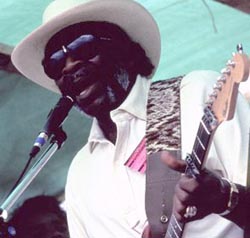
Dr. Harry Oster, English professor at Louisiana State University (LSU), began to attend some of these Zachary jam sessions and found Cage to be "a great representative of the now virtually extinct 19th century Negro fiddle tradition" (Oster 1969). Oster observed this in 1960s and one could imagine that the blues fiddle may easily have disappeared, but that is not the case. The jam sessions around the Baton Rouge clubs and bars will occasionally produce a fiddler, although admittedly there will often be heavy tones of Cajun and zydeco in the playing.
Clarence Edwards' "Done Got Over" on his Swamp's the Word album, has a definite zydeco feel to it, incorporating polyrhythmic clapping, a washboard, and guitar which forms a background for the fiddle. The fiddle repeats the melody between vocal lines in a call and response pattern, taking the place of where one might expect to hear it.
Despite the retention of traditional instruments, the years immediately preceding World War II brought a definite change in the sound of the south Louisiana blues as it did throughout the states. The south Louisiana blues musicians started imitating the amplified sound of the bestselling artists of the day that they were hearing on the radio and recordings. Inspiration ranged from such stylistic diversities as Texas' 'Lighting Hopkins' and Mississippi's John Lee Hooker, to the Chicago sounds of Sonny Boy Williamson and, most particularly, Jimmy Reed. With wailing harmonica and electric guitars booming over the wallowing sound of muffled swamp beat, the local musicians started to make their mark in the juke joints and bars. The 1950s saw the beginning of the development of south Louisiana urban blues, and by the end of the decade, the bluesmen begun to establish their warm recognizable style from the borrowed sounds. The style became known as "Swamp Blues," and Baton Rouge became its home.
Exactly when the term originated is unclear, but there exist several origin narratives. Silas Hogan, who was eighty years old at the time of this interview and was the oldest active bluesman in Baton Rouge, claimed that it refers to the Devil's Swamp, just on the edge of Scotlandville, where most of the bluesmen had lived for the past fifty years. He remembers how they would hold jam sessions on the porches of their homes, overlooking Devil's Swamp. So the name 'swamp blues' seemed appropriate and the bluesmen started referring to their highly percussive sound as the 'swamp sound.'
When I asked Lazy Lester about the designated swamp sound behind stage at the 2017 Baton Rouge Blues Festival, he replied:
I was right there in [J. D.] Miller's studio when we talked about trying to find a name for our sound. Miller said everybody in other regions have a name, Mississippi Delta sound, Piedmont sound, we also need to name our sound. So, we thought about the Louisiana swamps and we just started calling it the swamp sound right there in that studio.
During an interview a couple of days before the River City Blues Festival in 1986, I asked Tabby Thomas to talk about his style of blues, he said he was trying to define it as a Louisiana style:
The rural blues was so simple to it's complicated. I was trying to make it as modern as I possibly could but still retaining the raunchy and raw flavor of the music like Muddy Waters. I am trying to define it as a Louisiana style of music. I think Louisiana has a style because you see most of the music of Fats Domino and [Professor] Longhair and all those guys. And by me playing the piano, then I am able to go back and draw from the piano playing and add some of that to the guitar. . . . You understand? I can play the style of Allen Toussaint, Professor Longhair, and I had to play all of Fats songs. I had to play "Blueberry Hill" and all of that you know. Rock and roll became popular in '68, '69, '70. and '71, and if you did not play Fats, they did not want you in the club. Fats Domino was the hottest black bluesman to come out of Louisiana. He sold 80 some million records. If you played some of his music, you were all right. Now, I don't have to sing anybody's stuff but mine. I have my own album now, so I play my own records.
Tabby played the "mixed up" style as referred to by Silas Hogan or better known as the urban blues. However, Tabby put his own Louisiana twist to it by combining the New Orleans rhythm and blues piano style of Longhair, Domino, and Toussaint. Performing works of others or covering other performer's songs is not unusual in the music business. This is what Tabby did until he came into his own style in trying to keep it "raw and raunchy" while incorporating the style of others—the New Orleans rhythm and blues style.
I asked Raful Neal II and his brother Kenny Neal about their thoughts on the development of blues in Baton Rouge:
Jackson: Why do you think Baton Rouge was like the Mecca of the blues in Louisiana? Why was blues so prominent here instead of other places in Louisiana?
Neal, R.: It was because of the people leaving the little country towns around and coming to Baton Rouge. We talking about the people from Erwinville, St. Francisville, all them people coming in this area to Baton Rouge. Everybody started coming from Clinton and all to B.R. instead of going north. It was some people coming because of the [Mississippi] River to BR. Because of the [chemical] plants and stuff and they came down. And it took the Tabby Thomas, the Raful Neal, the Slim Harpo to stick together and build this blues thing. You go back 100 years ago and there was no blues in B.R. You had your Cajun in Lafayette, you had you jazz in New Orleans a long time. The blues was people that we could relate to. I am 57 and I can remember the Tabby Thomas, the Lightning Slim, these guys from Baton Rouge stuck together and built this blues here. Now you had it in Memphis, you had it in the Delta, and when they started doing their thing and sprouting out, they said. "Oh, it is blues somewhere else." That is why Buddy Guy left [in 1957] and went to Chicago, because there is a lot of blues. But the blues in Baton Rouge was just starting around that time. We go back to about the 1930s, there was no blues in B.R., except in Angola [Prison]. All them guys we talking about, I remember them when I was a little boy.
Jackson: What do you think is the Baton Rouge sound? Is there a regional sound from Baton Rouge? What makes it different?
Neal, R.: Well, it is totally different. I could walk up at the Blues Fest downtown and I can pick up the area that a musician is from just by listening to him play.
Jackson: What do you call the style of blues that you play?
Neal, R.: I was playing down town at the [River City] Blues Fest years ago. Luther Allison and Larry Garner was walking and Luther ask Larry, he said, "Goddog, man, who that is on guitar?" Larry said, "Man, that is the dude they call Lil' Ray Neal. I would know that sound anywhere." They came to the stage after I finished playing and we talked. Larry said, "Man, I don't care where I am at, when I hear you, I know that's you." That's the kind of sound I got. I play the blues. I don't try to play no Chicago blues. I don't try to play no Delta blues. Lil Ray plays what he feels at the time.
I asked Kenny Neal the same question pertaining to his style of playing the blues.
Neal, K.: I combine the deep roots of the blues that my dad played with when I was growing up. I listened to people like Larry Graham, Sly and the Family Stone, and these other groups we called funk and rhythm and blues. So, I kind of combined the two and kept a little bit of that Cajun stuff as well west of Baton Rouge. It is a combination of stuff that's why we named it Swamp Blues. . . . My rhythms and everything is more upbeat, but my groves are still bluesy like my father use to play old traditional.
We had so many of the real true bluesmen here in Baton Rouge. We still had that true Mississippi stream coming down through here and a lot of them blues stuck right here in Baton Rouge. We had great hit records out of Baton Rouge. . . . We haven't had the recognition that we deserve. I was glad to be a part of helping to put Baton Rouge on the map for the last 30 some years, I have been out touring.
Jackson: Why do you think we did not have a lot of hit records here? Do you think it was because we did not have any prominent or close recording studios?
Neal K.: There was some local recording studios because I have some records in my music room that came from right here in Baton Rouge. Lionel Whitfield, who went to Southern, taught at Southern University, he had a small recording studio. He would record people like Bobby Powell, Raful Neal, and Chuck Mitchell. These guys recorded locally and he would put them out locally, but we could not get that national and international distribution. That was the big problem for Baton Rouge. And another thing when the promoters come down for the blues, they would go to Chicago. If they are coming from abroad, because that was supposed to be the home of the blues. Or [they'd] come down to New Orleans, but they wouldn't never come to Baton Rouge to scout. We kind of got lost, but at the same time we really got great artists who really hit big out of Baton Rouge.
Jackson: Like that Slim Harpo guy. Right?
Neal K.: Yeah, right. I was in New York and they were playing the Top 40 music and all of a sudden, "Scratch My Back," came on in the middle of all that. I said, "Isn't this amazing?"
Jackson: He was truly appreciated by Europeans.
Neal K.: Yeah, well they helped preserve it. When the disco music came back in the early [19]70s, the blues musicians really did not have nowhere to play and so that just shut it down. I remember my dad hanging his hat up and putting his harmonicas up because there wasn't anything happening. And at the same time, Europeans say, "Wow, we gon' do blues festivals." And they were the ones that kept us afloat.
Ashton Savoy's transition to the new urban sound is possibly typical of the musical development of many other young musicians during the 1950s. Savoy was born 1932, in Sunset, Louisiana, the heart of Acadiana. His father was a violinist and guitarist, who played Louisiana country blues and La-La. Despite efforts to pass on his own musical traditions to his son, Savoy turned his attentions to what was being played on the local blues radio station. His father played in the rural style of Texas bluesman Blind Lemon Jefferson, but Savoy, like many of the Louisiana bluesman of a younger generation, was interested in the Chicago sound of Jimmy Reed. Silas Hogan confirmed that from the late 1950s and throughout the following decade, Jimmy Reed was the bluesman who everyone in Louisiana was listening to and drawing ideas from. His walking bass, slurred lazy vocals, and use of the upper regions of the harmonica have all become an integral part of the Swamp Blues sound. The influences still clearly audible at some jam sessions today in Baton Rouge.
These range from the traditional sounds of Silas 'the Godfather' Hogan, to the more contemporary preaching style of Larry Garner, whose uncle taught him how to play using many of Jimmy Reed's numbers. Two of the most commercially successful swamp bluesmen have had their sound attributed to Jimmy Reed: Slim Harpo and Lazy Lester. Lazy Lester helped pioneer the Swamp Sound, through accompanying guitarist Lightning Slim, but also had considerable success on his own. He claims Jimmy Reed as his major influence, and two years after Reed's own 1961 hit with "Baby What You Want Me to Do," Lester released a welcome cover of the same song.
Ashton Savoy, perhaps listening too intently to the blues sounds being played over the local airways, dug his own musical grave. By adopting a style so closely imitative of Jimmy Reed's, he found that he could not find a producer interested enough to record him, and by then it was difficult for him to drop his adopted style.
Lightning Slim opened up the Baton Rouge blues scene after successfully releasing the single "Bad Luck" in 1954. One of the many local musicians playing in the style of the Texas bluesmen, Lightning Slim started out by imitating Lightning Hopkins. Hopkins was the epitome of the Texas blues singer, an outstanding emotional singer who typified post-war blues with his lighter guitar work and independent sound between instrumental and vocal line. The Texas blues style is lighter, more melodic-sounding than that found in other blues forms. A relative lack of racial tension in Texas resulted in a more relaxed blues style than that found in Mississippi, or Chicago. The Mississippi Delta blues retains more African elements: a very strong blues incorporating groans, hums, and yells. War-time industry needed unskilled workers, which resulted in a mass exodus from the Delta regions to Chicago. The fusion of the African-based Delta sound with the more sophisticated sounds of the jazz city of Chicago resulted in a new post-war blues, which became known as Downhome Blues, a reference to the recent migration from the south. The sound incorporated jazz instruments, and by the late 1940s many bluesmen were playing saxophones, trumpets, and clarinets. Surprisingly, considering the jazz traditions of New Orleans, these instruments have not infiltrated the Swamp Blues sound. Apart from Jimmy Reed's lazy vocals and strong walking bass, the Louisiana Swamp Blues seem to have drawn little from the Chicago sound, the influences from Texas are undoubtedly stronger than any others. The economic climates have had much influence for the exchange of musical styles. As mentioned above, the mass migration from Mississippi to Chicago resulted in a new blues form.
Similarly, the itinerant bluesmen from Louisiana found work relatively easily in nearby Texas and there was much movement between Texas and south Louisiana as the itinerant workers and bluesmen wandered from job to job and from gig to gig. The fact that the smoother, sophisticated sound of the horns that were becoming an integral part of the new Chicago sound never became absorbed into the Swamp Blues sound. Despite the traditions of such instruments from nearby New Orleans, the absence illustrates how confident the Louisiana bluesmen already were, with their own distinctive sound, the lazy, wallowing bass, the muffled drums, and melodious vocals.
The new zydeco sound was developing at the same time as the urban Swamp Sound, and inevitably musical influences were exchanged between the two forms, as many of the musicians moved freely between playing both blues and zydeco. Lightning Hopkins, played the Houston clubs during the 1940s with La-La musician and washboard player Cleveland Chenier, brother of Clifton Chenier.
Recording Industry and Awards
Lightning Slim's success with Hopkins' light Texas style, under Crowley record producer J.D Miller, resulted in Miller being consequently encouraged to start focusing his attentions on the local bluesmen. The Cajun and country market, which had formed the backbone of his business up to this point, was rapidly declining due to the surge of interest in rock and roll. Lightning had been brought up listening to family records of Blind Lemon Jefferson, and had later developed an interest in his protégé, Lightning Hopkins. Lightning Slim's first practical musical experiences were in Baton Rouge during the 1940s, when he worked in a chemical plant and spent his leisure time with older traditional country bluesmen playing house suppers and country dances. Today, Slim's recordings sound basic, with strong rural elements: a sparse guitar, crude harmonica, and simple drum beat, but with this sound he helped lay the foundations for the contemporary Swamp Blues sound we hear today in the city. "Bad Luck," recorded in 1954 was Slim's first single; it was almost a minor hit, and forged the beginning of a relationship with Miller that would result in 66 sides of his music being released.
The healthy post-war economy gave rise to recording companies springing up in locales more easily accessible to the local musicians. Whereas previously Louisiana bluesmen were either recorded at a field session at Angola Prison Farm or taken out of state to record, they now had easy access to a local recording studio, which, in turn, gave them more control over recording their music. Miller was in a good position to start successfully producing the bluesman's sounds.
Geographically, he was on US Highway 90, the main road between Texas and Baton Rouge. This was an important factor, as with the exception of Lightning Slim, all the bluesmen that recorded their initial contact with him, did so by making their own way out to the studio. Crowley is, however, 80 miles from Baton Rouge. Not only geographically, but also culturally, he was well placed. As a local person he was attuned to the styles and sounds that would appeal to potential local listeners. Miller himself has been instrumental in formulating the south Louisiana blues style, which has become synonymous with the term Swamp Blues. By the 1950s, when he became interested in recording blues music, he was already recording Cajun and zydeco music, and as a producer who was very much involved in developing the musicians' styles, influences from the production side have played an important part in the development of the Swamp Blues sound. With the exception of Clarence Edwards, who said, "I just never made it over there I guess," every Swamp Blues artist who has recorded has done so, at one time, or another at Miller's Crowley studio.
Within a couple of years of Lightning Slim's success, Donaldsonville guitarist, Cornelius Green made the trip over to Crowley. He had spent part of the previous three years jamming in Port Arthur, Texas, which had led to a meeting with Clifton Chenier, who immediately hired him and took him on tour throughout the South and California. Miller immediately liked Green's powerful husky voice and commanding guitar style, and produced 16 singles and one album for Green over a period of nine years. The first influence Miller had over Green was to establish a more commercial identity for him. He re-named him Lonesome Sundown, an appropriate accompaniment for his gloomy music. The name was appropriate also in respect to where he made his home on his return to Louisiana from Texas, a few miles outside of Sunset, Louisiana.
Miller himself was also a talented song writer throughout the golden years of the Crowley blues sessions-mid 1950s to 1960s. He wrote "My Home is A Prison" for Sundown at a recording session, after receiving a telephone call from Sundown's wife letting him know that she was unhappy with her husband being in the music business. As is inevitable in the music business, there has been controversy between Miller as producer and his artist when it has come down to the origins of a song, and there have been numerous royalty disputes. Perhaps, the most widely discussed example today is Slim Harpo's "Raining In My Heart," which is Slim Harpo's and indeed the Swamp Blues biggest ever commercial success. Recorded in 1961, Miller claims Slim Harpo came to him with nothing more than a title and an idea, yet today Slim's widow still maintains that she warned him as he was leaving for their recording session not to give Miller the song. The origin is still not settled, but the song put the south Louisiana blues sound on the international blues scene. The rhythm-and-blues influenced recording was on the charts from May to July 1961, peaking at number nine.
Realization that the recording world had to accommodate the public's taste—although Miller himself preferred what he calls "old guitar gutbucket blues"—he continued to experiment with the sounds that musicians were streaming into his studio with. According to Miller, Slim Harpo, despite his virtuosic harmonica playing, had a less than mediocre singing voice. Consequently, Miller asked him to try singing in a nasal tone for the first single they cut, "I'm A King Bee." It worked well, and Slim adopted the style.
Slim Harpo became a strong influence of the British rhythm and blues scene during the mid-1960s. In addition to the Rolling Stones having recorded "I'm A King Bee" and "Shake Your Hips," numerous other bands appreciated the lazy melodic south Louisiana sound of Slim Harpo. The Kinks cut, "I Got Love, If You Want It," so did The Pretty Things, who also recorded "Raining in My Heart." Van Morrison released "Don't Start Crying Now" as his first single with his group, Them. Dave Edmunds cut "Shake Your Hips" before the Rolling Stones. Here in America there was a less than enthusiastic response to the idea of covering Slim's songs and those who did so are said to have been imitating the English cover rather than Slim Harpo, himself.
Miller had to work hard during the 1960s to produce records that would be competitive in light of the wave of interest that was being shown by American audiences towards the British Rhythm and Blues scene. As Miller says, "The Beatles tore a hole in black music." John Fredd, Baton Rouge singer famous for "Judy in Disguise" points out the irony of this, "We lost our identity for a time during the 1960s, the Beatles were imitating American music and Americans were trying to play the Beatles music" (Broven 1987: 118).
The fascination with the British Rhythm and Blues scene, coupled with the blues issues of the Civil Rights Movement caused the Crowley blues sessions to drop to almost a standstill by 1967. "The blues sales just dropped off as we got into the civil rights affairs," says Jay Miller. "The Blacks didn't want anything to do with the old days, regardless of what it was good, bad, or otherwise" (Broven 1987: 149). Pianist Robert Milburn noted in the early 1970s, people don't care for the blues. If I go in a black club and play the blues, they want the latest-up to date stuff (Beyer 1980: 45). The feeling of disillusion amongst the Black population spread from the audiences to the musicians. Tabby Thomas remembers:
There wasn't too much blues played around here during that time, (late 1960s, early 1970s) 'cause most people listen to the radio, and if you isolate them records, don't play them on the radio, then they don't really get into it. That's what happened at this time you, see? You isolate musicians, they don't hear their kind of music on the radio, well man, they just gonna lose interest. The radio, people just playing rock and roll, so people don't get a chance to hear them [blues], so they don't 'bother to play, they don't really go for it much see?
There were certainly a number of key bluesmen on the Baton Rouge circuit who hung up their instruments during the blues slump, most notably Clarence Edwards and harp player Raful Neal, who had been playing around the city venues with Buddy and Phil Guy before they left for Chicago.
The New Era: Civil Rights—1960s
Segregation was upheld throughout Louisiana and the rest of the south, officially, until 1954, when the Supreme Court decided it was unconstitutional. However, the following years saw southern white opposition to desegregation mushroom at every level of society. Jim Crow laws were passed in Louisiana reinforcing separate Black schools. Louisiana even "amended the state constitution to provide that, to promote public health and morals in their schools" (Manning 1984: 47). As the movement towards desegregation gained momentum, white supremacist and terrorism became more violent - Louisiana courts ordered the NAACP to halt a public meeting in the state. The Black population, who up until the 1960s, had made up practically all of the blues market in Louisiana, began to find a newer, more aggressive pride in their African American culture. They no longer wanted to be associated with the bad old days and the music that was such an integral part of them- the blues. Instead, they turned their attentions to soul music, the new vehicle of musical expression for the Black population.
Festivals, White Clubs, and Fraternity Row
The city's bluesmen did not completely disappear into obscurity. At the other side of the city during these difficult years was the emergence of rhythm and blues and rock and roll, both of which attracted White audiences. As the bluesmen lost their own audiences, many compromised their own blues styles and started playing rhythm and blues cover versions to attract White audiences. During the 1960s, for the first time, the bluesmen started playing in White clubs. The Glass Hat, now extinct, on North Boulevard was one of the most popular music clubs. Slim Harpo and Silas Hogan, with their respective bands, each had regular bookings there. Silas remembers, "the boys that were playing for him (Slim Harpo) at the time, they were more into rock and roll, and they don't get low down, low-down sound no more." Fraternity parties were another avenue for attracting White audiences. "Slim Harpo was playing down there, too, at LSU, big old hall, the girls would kick their shoes off and get down there and do the twist. We had them flying out there." But for the Black audiences that were left who still wanted to listen to blues, Baton Rouge itself had nothing left to offer. The bluesmen playing in their traditional styles had disappeared back to the venues of twenty years earlier where the rural jam sessions had flourished. Tiny one-room clubs and bars in Scotlandville like the Elks Club housed many of the bluesmen for the next decade or so, and they extended further out in Tunica, just off from Highway 61, The Black Cat Lounge became a popular venue.
One of the reasons that Slim Harpo never reached his commercial potential, the kind of popularity that Jimmy Reed had, may well be the attitudes in the South during the 1960s. The segregation and racist attitudes in the south inevitably led to a limited sales market, which then doubled its effect when the Black market also turned its back on the music. Slim Harpo's friend, singer John Fred says, "Slim could have been big, he was like Lead Belly and those other guys, they were kids trapped in the South, they were just born at the wrong time. Slim Harpo's generation was awful rough on the Black man, you got to remember that."
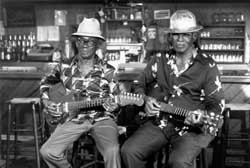
During the early 1970s, the record companies Arhoolie and Excello capitalized on the growing popularity of the blues among students and other young people, and produced compilations of Swamp Blues, featuring Tabby Thomas, Silas Hogan, Whispering Smith, Clarence Edwards, and Arthur 'Guitar' Kelly. With the exception of Mose 'Whispering' Smith, who died in 1984, twenty years on, these musicians still form the backbone of the very active Baton Rouge blues circuit.
"The seventies were a bad time. The radio played no blues at all from sixty-nine onwards, and we all had a hard time hanging in there," says harp player, Raful Neal. However, hang on they did, and the opening of Tabby's Blues Box and Heritage Hall in 1981 proved to be a turning point for the blues in Baton Rouge.
Henry Turner also was trying to get a foothold on playing the blues and rhythm and blues in the 1970s. He honed his craft by playing at fraternity parties at various universities, LSU being one of the main ones.
Henry Turner: I had been studying the top 40 play list since I was about 18. I went to the phone book and found a booking agent. I went over and knocked on the door. The place was on Acadian Thruway and Perkins Road, upstairs. Band Aid and Entertainment. I knocked on the door and talked to the guy and told him I do Top 40s music. He was a white guy and he asked me if my whole band was Black and I said, "Yes." He talked for a little while and brought out the Top 40s list and I said, "Yes, we know a bunch of these tunes." A couple of weeks later, he called me up and said, "Can you go over to LSU and play this fraternity gig?" I said, "Yes, we would be glad to. Where is it?" He gave me the address and said it is at the D____ House. So, I go over and sign the contract for $750. I asked if he had made a mistake before I signed because we usually make about $150 a gig in the neighborhood. . . . So we go to play this party at the D____ House. Little did we know that the D____ House was the wildest fraternity on LSU campus. So we arrived and set up our gear on an outdoors stage set up on the lawn. At this time the drinking law had not been enforced at LSU. It was still a college where you could drink at 18 and it was the last of the holdouts, but I did not know it then. So we go and get set up and the president of the fraternity comes over to me and say. "Are you the guy in charge?" And I said. "Yes." He introduced himself and said at the end of the night, man, you will find me upstairs in my room face down. Just turn me over and get the check out of my pocket, man. I said, "What? Get the check out of your pocket?" He said, "Yes, we party pretty hard, so I will have the check. Don't worry about that, but I might forget to give it to you. So come on up and get it. It's okay." So I told the rest of the band and they looked at me funny. So we started playing the gig and all the sorority girls started coming in and guys walking around with fifths of Jack Daniels in their hands pouring drinks. Then they came out in front of the stage and started partying and started doing some chants and then all of a sudden they broke out with these funnels. They brought out these guys who I guess were pledges and made them get on their knees right in front of the band and they put a funnel in their mouth and started pouring alcohol in their mouth through this funnel down their throat. We are in shock on stage playing and looking at each other! Is this really happening?! We are in shock! So we take out first break and look are each other and say, "We are probably going to have to go and get that check out of his pocket. They all gon be wasted." By the time our third set was over, we were playing for three people. People were laying out all over the lawn, passed out in the door to go in to the house, another guy laid out on the hood of a car. We said, "Oh man, what in the world did we get into?" So we go upstairs to find the guy. He had passed out on the floor, not in the bed, on the floor, vomited and everything. We turned him over and got the check out his pocket and we go back down the stairs. We had already packed up so we were getting in the car when a guy called me and said wait a minute come here. He said, "Ya'll did a really good job. So what I want ya'll to do is go in there where the bar is and take all that alcohol because we are not supposed to have it in here, so take it with you." So we go and take all the alcohol--fifths of Jack Daniels, fifths of scotch, fifths of vodka and all kind of stuff and put it in the van and take off down Highland Road laughing and saying this is insane. It was crazy.
So we started playing other frat parties at LSU, then we started getting calls from Tulane, then some from up in Ruston and different other places.
Jackson: You all were traveling the university circuit?
Turner: We called it the fraternity circuit. We were all over the frat circuit. That took us all the way to about 1983 and I was getting fed up with the whole everybody drunk blah, blah, blah and all of that.
It's a Family Affair
Raful Neal, Kenny Neal, Lil' Ray Neal
Raful Neal (1936-2004) was the patriarch of the largest blues family in Baton Rouge. He and his wife, Shirley had ten children that were all involved in the blues at one time. They even have two grandsons that are blues musicians. An article that was published in 2002 by Phil Brady, "Raful Neal: Big Bad Bayou Dad," provides a breakdown on all the Neal children and grandchildren involved in the Baton Rouge blues scene:
Sons Kenny Neal and Lil' Ray both have their own bands. Darnell plays bass for Kenny and Frederick plays keyboards. Noel is in Chicago, bassman with James Cotton, Larry is an awesome harp player and Ronnie plays drums. Jackie Neal [passed in 2005] has her own band, with Graylen on drums. Twin sisters Charlene and Darlene sing part-time backup vocals. Charlene's son, [Raful's grandson] Tyree has his own band. The Tyree Neal Band. They came in second in the International Blues Foundation Challenge in February. Tyree won the Albert King Award for the best guitar player out of 52 bands. Grandson Josh, Lil' Ray's son, plays bass with Moonshine, an upcoming, young Baton Rouge blues band.
Although the above account by Phil Brady is from 2002 most of the siblings and grandchildren are still involved even more with the current blues scene. If it was genetically possible, one could certainly say that the blues is a part of the Neal families' DNA.
Raful Neal started his blues journey after listening to Little Walter on WLAC radio station in Nashville, TN in the early 1950s. He purchased a copy of the 78 rpm recording of "Juke" and repeatedly played it on the old gramophone until he perfected the sound. Walter was his earliest influence, and he finally got a chance to see him along with other great blues performers, including Muddy Waters, Lowell Fulson, B.B. King and Junior Parker at the Temple Roof Garden in the Mason's Temple building in Baton Rouge on North Boulevard. He also saw Little Walter at a later time at the Purple Circle, another venue in Baton Rouge. This time he was able to play on the break with his band, which at the time consisted of Buddy and Phil Guy on guitars and Charles Crose on drums. It was during this moment that Little Walter's drummer O Pie Payne, was so impressed that he invited them all to come to Chicago, but it was only Buddy Guy that accepted the offer, and the rest is history.
During the 1950s and 1960s, Neal was busy playing gigs--sometimes 11-12 a week--not only in Baton Rouge, but also the surrounding cities like Plaquemine, Alexander, Monroe, and others, as well as fraternity parties at LSU. Starting in 1959, he released a number of 45s on Peacock— "The Sunny Side of Love," and "Getting Late in the Evening"—and others on the La Louisiane and the Tick Tock labels. The blues scene changed in the 1970s, so Neal had to get a day job. He started working at the East Baton Rouge Parish Housing Authority, where he stayed for the next 20 years while at the same time playing three to four gigs a week. He also continued to record; for instance in 1987 his Kingsnake record album, Louisiana Legend, was released and distributed on CD by Alligator Records and his I've Been Mistreated CD was released by Ichiban Records in 1991.
For Neal, the 1980s brought about more festival gigs. He helped to organize the first River City Blues Festival in 1985, and performed for several festivals, including the New Orleans Jazz and Heritage Festival and the San Francisco Blues Festival. Club Louisiane released Raful Neal, Old Friends on CD in 1998 and in 2001, Telarc released Hoodoo Kings with Tabby Thomas, Raful Neal and Eddie Bo, New Orleans pianist. Until his death in 2004, Raful Neal and the Clouds had been a steady band consisting of James Johnson, from Slim Harpo's band, on guitar, Roy Stewart on drums, and A. G. Hardesty on bass.
Raful Neal's oldest son, Kenny Neal, started playing when he was about six years old, but Slim Harpo stuck a harmonica in his mouth instead of a pacifier when he was three to stop him from crying and it worked; he liked it immediately. He was so fortunate to be surrounded by notable blues performers like Buddy Guy, Lazy Lester, and Slim Harpo from a very young age. Ruddy Richard from Opelousas actually taught him chords and the rest he learned "by ear and heart." His father bought an old piano from the church and he started practicing songs on it. His father featured him on one of his shows when he was six years old. Kenny played on keyboards Ray Charles' "Tell Me What I Say." After that three minutes of fame he was hooked, but realized early on "that it was more difficult to haul around a whole piano to the gigs so I had to learn a string instrument that I could just pack up and go." So, he started sneaking around to practice the bass guitar. Finally, at age 13, his father brought him in as an alternate member of the band when his bassist was absent. He went on to join Buddy Guy's band in 1976 at the age of 17, then after about three years, he moved to Toronto and formed a band with his four brothers, calling it the Neal Brothers Band, which basically backed up other guest blues musicians like Big Mama Thornton, John Lee Hooker, Junior Wells, Buddy Guy, and others. After about a year and half, the other brothers went back home and he went solo.
Kenny plays multiple instruments including piano, bass, guitar, harmonica, and trumpet. His sound is influenced by traditional country blues, rhythm and blues, funk, and classic swing. His more prominent CDs include Hoodoo Moon, Bayou Blood, Devil Child, Walking on Fire, Big News from Baton Rouge, Louisiana Stew, Bio on the Bayou, a Tribute to Silas Hogan and Raful Neal, Hooked on Your Love, Kenny Neal and His Mississippi Saxophone and Bloodline which was released in 2016 two weeks before our interview. Kenny is one of the more successful Baton Rouge bluesman to make a career of performing the blues and had a chance to branch off into acting with a theatrical project. He starred in Langston Hughes and Zora Neal Hurston's Broadway play Mule Bone with Taj Mahal's musical score in 1991. He was awarded the Theater World Award for his performance and Most Outstanding New Talent in an Off Broadway production. He states that these awards were the most outstanding for him simply because it was for something he does not normally do and he really had to work hard at it.
Kenny Neal is active in several of the community's efforts to preserve the Baton Rouge Blues culture. He shared how he works in schools:
I also like to go to the schools. I do Blues in the Schools. I perform for them and talk to them about the blues and I think that is what needs to be done to keep the blues alive and take it to the next generation. The younger kids are not familiar with them. They say, "Oh I know the blues. My mama' nem like that stuff." Then you catch then at a early age at school and then I go and sing all these old blues song and them babies are having a great time, you know. So that's why I want to catch them young. . . . I like to work with young kids. In fact I have a young band now that I am going to have them open up for me at the Balloon Fest in Gonzales in September. They are all students from different areas, but they go to the Baton Rouge Music. I go over there and work with them and perform a bit, but I want to give back to the community.
I think it is very important for me to carry on for the younger generation because if we don't do that we will end up losing it. I play for a mixed audience, Black, White, Asian, but we do not have a lot of our African American folks where it comes from to come out and enjoy it. They would enjoy it if they would come out, so I am staying in this thing because it is important to pass it on to the next generation and let them know this is something that we have that we should be really proud of because it is the beginning of American music, it is the roots of American music. Anything you listen to today came from right down here in the South and we should honor that and want to cherish and carry it on. So, that is why I am into it to keep it going. If I drop out, then I will feel scared that it won't happen. I am here for the duration.
Raful 'Lil' Ray' Neal, III is the third son of Raful Neal, II. Like Kenny, he grew up with bluesmen frequenting his home to be near his dad. They all started playing their instruments by ear, then had some training later. Lil' Ray started playing when he was nine, but had an interest before then. He first played the trumpet, then went to the guitar. He started gigging when he was thirteen in Erwinville, Louisiana at Spooners, a family-owned establishment where people could bring their children. They would play when his dad's band would take a break and later he played at other clubs there when he was old enough. After they moved to Baton Rouge in 1976, he played in Capitol High's Jazz Band under Mr. [Henry] Grey. When he came of age, Ray said, "We played every Black and some White clubs in Baton Rouge. You name it and we was there-Parker's Lounge, Pices, Payton Place, Teddy's Juke Joint. I mean anywhere we played, my daddy was playing every Thursday, Friday, Saturday and Sunday. Paradise in Port Allen, Maringouin, and Byrd's Satellite Lounge every weekend."
Yes, I played with my dad until I went on the road with Lil' Milton in the [19]80s and in the [19]90s I went with Bobby Rush, and then back with Lil Milton and then Bobby Blue Bland. I stayed with Bobby Bland for about eight years and then I left Bobby and that was when I got my own band, the Lil' Ray Neal Band. I was still playing with my daddy, though. You just don't stop that. You did not even have a choice. I remember I used to be coming in from Bobby Bland, I get in, tired of driving and all of that and my daddy call and say, man where you at. I said, I just made it home and he would say, well I am playing at so and so tonight and I need a guitar player. Now anybody else, I would tell them I am tired and I could not do it. But with dad, there wasn't even no question. He just tell you what time. He wouldn't even ask you could you make it, he would just tell you what time it was.
He started the band in between playing with Bobby Bland and other bands he played with, but when he came off the road in 1997-98 he became serious with it. He had his band for a while, but would always book his band when he didn't have a gig with another artist he was working for. When he came off the road, he bought the tour bus for his band.
The members are some of my brothers and others are, well we call him Charlie Hall, but his real name is Charlie Birch (guitar), Oliver Wells on drums, and A.G. Hardesty was my bass player.
The next change to impact the music scene in Baton Rouge was the opening of the casinos. Baton Rouge has two riverboat casinos that opened in 1994 and 2002 in addition to a hotel casino that opened in 2012. They offered live music, but this didn't help the blues musicians in Baton Rouge. Raful Neal III reflects on the opening of the casinos:
The casinos started opening up and killing all the good night clubs and juke joints. The music kind of fell. In the casinos you could drink free, could hear the best bands for ten dollars. You know a club that holds seventy-five people gon' have to charge more than that to get that same artist because they did not have enough seating, but some casinos can hold a thousand people. So, it is a money thing. . . . I have played more casinos out of town then I do right here in town. It is just hard to make it in your hometown.
He talked about the difficulty of being a working musician in his hometown:
Kenny moved back here from California and he works more in Baton Rouge the anybody around here and the people that lived here and built the Blues Festival and all this stuff, it is hard for them to get a job, but you can come from out of town, move here and work more than the people that been here. I don't know how that works. . . . Now, it is hard for me to get a gig at the Baton Rouge Blues Festival and Kenny can come to town and get the headliner and all that because he been away. I don't think it is fair but that's how it is. Now, I play out of town more than I play in Baton Rouge. I thought about going down to talk to the people, maybe they think I am not playing anymore. I do a tribute to B.B. King every year in Indianola, MS. On B.B. King Day, I am one of the headliners, but everything is out of town. Then they give Live After Five in Baton Rouge and they don't call me. They do the Blues Festival and they don't call me. I just have to go out of town, but I have played with some of the best, even Ray Charles.
Lot of times people do call me, but the money they offer me for the 40-45 years I been out here I just can't play for that. [They should] offer me the money that you give the other musicians. I don't want a whole lot, I just want enough to compensate the guys that are coming. . . . Last year when I had a little spot at the Blues Festival, I had three horn players. . . . I goes up there and put on a hell of a show everybody tells me. Then the pay compared to is nothing that I have to pay my guys out of, but I still pay them and if I make something fine. . . . If I don't, I still make sure I pay them guys. You see, my horn players, some of them come out of B.B. King's band after he died, so it ain't nobody that I am just picking up off the streets, you talking about good musicians that want to play with you. Somebody else call them and say, "Man I got a gig and it's in Louisiana," they not coming, but if I call them and say, "Man, I got a gig in Louisiana," they coming. It is probably because of the type of music I play and I treat you well. If I make $2500, I am not going to make no money, because I pay them well. I'm gon' make sure they paid and they on their way. If something is left, I get it and if not, I shake they hand and we try it again the next time. Then I can go right there in the Mississippi, in the Delta and they pay me three times more than what they pay in Baton Rouge. That's right!
Rahul Neal continues discussing working conditions for musicians.
Lil' Milton, we became best of friends and he said, "Man if you live long enough, people gon' recognize you. I played all my life through the Delta and everywhere and then in my older days, I started making a lot of money and the people started calling me so much I had to turn down gigs. He said, "I was in my 60s before they did it." Also B.B. wasn't making money 'til, B.B. had to be in his 50s. I'm in my 50s now you know. Buddy Guy didn't really start making money 'til late. Musicians, blues musicians, it take a long time before they really start making money. When you can do, just say five gigs a month and live comfortable, then you making money. But if you got to run up and down that road every night and at the end of the week you still ain't got no money, then something ain't right. I just don't do it no more. I did it. I use to run and play there, play here and play there and after you pay your band, your transportation and your motel and all you come back and you might get a $1000 dollars. It just ain't worth it so now I try to wait for the bigger gigs. I got my mechanic shop and I work on antique cars and that pays the bills.
Ernest Tabby Thomas and Chris Thomas King
Tabby Thomas (1929-2014) is another blues patriarch who was prominent in Baton Rouge for many decades. He and his wife, Joycelyn had seven children and one, Chris Thomas, developed an early and lasting interest in the blues. Thomas had musical influences from his teen age years singing in the St. Luke Baptist Church Junior Choir and in a gospel quartet, patterning himself after an uncle that he was influenced by. He attended McKinley High, where he also participated in musicals before graduating. Afterwards he left Baton Rouge and moved to Detroit to live with an aunt and soon enlisted into the U.S. Airforce and served from 1947-1950. During his tour in Japan he worked on his singing. He settled in San Francisco in the Filmore District after his tour was over. One of his friends heard him sing and encouraged him to enter the talent show sponsored by a San Francisco radio station, KSAN at the Ellis Theater. Thomas entered and won the first-place prize of fifteen dollars, winning over such names as Etta James (then known as Jane Etta) and Johnny Mathis. Shortly after, he discovered a recording company near his job and decided to check it out on his lunch break. The producer recognized him from the talent show and stopped the session and asked him to sing a song with the lyrics, "Midnight Is Callin." That song was Thomas's first recording (made on his lunch hour) for Hollywood Records in Los Angeles.
Thomas came back to Baton Rouge in 1953 and always told the story of wanting to come back so bad that he gave away his Cadillac just for a ride to the train station. As the state with many bluesmen, by now he loved to play and sing the blues, but could not do it alone to make a living, so he took a job at a plant and performed the blues on the side. During this time it was very difficult for a musician to get their recorded music played on the radio and in clubs, but Thomas was determined to record more music, so he headed to Crowley to see if J.D. Miller was interested. Miller had written a song for Thomas, called "Tomorrow." He recorded the song that day and released it on Feature 3007. He went back for other recording sessions in 1959 and 61 which resulted in his most famous recording, "Hoodoo Party," released on Excello 2212. He released over twenty singles on his own label, Bluebeat Records, and eventually released an album in 1980, 25 Years with the Blues on Blues Unlimited 5007. The album is a retrospective compilation of Thomas' work over the years; it includes most of his better-known songs, and has done fairly well.
Thomas opened the Blues Box and Heritage Hall in 1978 or '79 on North Boulevard. He did not get too many gigs out of town, and he recalls he only got a chance to play in the early days on the Temple Roof Gardens—another Baton Rouge venue for blues performers—when Johnny Ace's band did not show up to back Willie Mae Thornton. Since Thomas knew Willie Mae from his stint in Los Angeles, his band got the gig and "rocked the house." He opened the Blues Box as a venue to perform his music, to showcase the music of other bluesmen in the area as well as to present new talent.
Tabby Thomas's son, Chris Thomas King, had a unique and privileged blues childhood filled with the sounds of various bluesmen on an array of instruments visiting their home and performing in the Blues Box. King played several instruments (guitar, piano, horn) and grew up playing with legends like Silas Hogan, "Guitar" Kelly and Buddy Guy. He recorded his first album, at age 17 for Arhoolie Records.
King won three Grammy's for his work on the soundtrack for O Brother Where Art Thou. In this film, King portrays the legendary bluesman, Tommy Johnson. He was praised for his acting abilities, guitar, and vocals. The Legend of Tommy Johnson Act released on his own 21st Century Blues label. Another acting venture is his portrayal of Blind Willie Johnson, in a six-part film series produced by Martin Scorcese for PBS. On his own label, he has also produced albums for other blues-based performers.
Buddy Guy and Phil Guy
George "Buddy" Guy (1936) was born in Pointe Coupee Parish in the town of Lettsworth, Louisiana, which is north of Baton Rouge. While he was still in Lettsworth at the age of 13, he started making homemade guitars out of wood and wire and taught himself to play before his Uncle Mitch finally bought him one. He moved to Baton Rouge to live with his sister, Annie Mae and to attend school, because all schools for Blacks in the region stopped at ninth grade, so they had to attend McKinley High School in Baton Rouge in order to earn a high school diploma. Buddy had to eventually drop out of school and take a job to help the family out when his mother, Isabelle, suffered a stroke. He worked at LSU in Facility Services until he left for Chicago. Guy and his brothers were going to hear the notable bluesmen of the era at the Temple Roof on North Boulevard. They heard B.B. King, Bobby "Blue" Bland and Junior Parker for 75 cents a ticket. By age 17, he was playing with the best of the performers in Baton Rouge, including, Slim Harpo, Lazy Lester, Lightning Slim, and Tabby Thomas. He eventually found steady work in a band with "Big Popa" John Tilley and later on Guy and his brother Phil Guy, played with Raful Neal's Band. Buddy Guy was the only one to go to Chicago and play with Lil' Walter. Although Buddy Guy was the superstar, his other brothers Phil and Sam also played the blues. Sam only played the drums at home when they were growing up in the neighborhood, but Phil, who also played guitar with the Raful Neal Band, eventually joined his brother in Chicago (Beyer 1980).
Buddy Guy went on to really make a name for himself not only in Chicago but worldwide with blues aficionados. Although Guy moved away from Baton Rouge in 1957 in the midst of the golden blues era, he is still considered one of Baton Rouge's greatest blues sons because he honed his craft here in the center of swamp blues personnel. He was tutored and mentored by the best of them and periodically he still goes "back home" in his playing style and continues to recognize where he came from. Over the years, he has also branched out to the rock and roll side, which has given him an even wider mass appeal, and where he also reaches a younger audience. He established his Legends Blues Club in Chicago, reminiscent of an urban honky tonk where one can feel right at home with the blues. When attending the Chicago Blues Festival, I visited Legends and after making it known to one of his waitresses that I was from Baton Rouge, Guy made it a point to come and visit me at my table with a brief conversation. When he played his next set, he recognized me and my party as homefolks, called us out by name and welcomed us to Chicago from the stage. His brother Sam says he visits home frequently and the Baton Rouge Blues Festival honored him in 2016 as he was the featured performer that year. In addition, LSU also honored him by conferring on him a Doctorate Degree, because when he worked there, Blacks were not allowed to attend. It was six years later that the first Black undergraduate student was admitted to LSU.
Silas Hogan and Samuel Hogan
Silas Hogan (1911-1994) was born in Westover in West Baton Rouge Parish and his family moved to Irene, north of Baton Rouge, two years later. He was born into a musical family: his father was a musician and his two uncles, Robert and Frank Metty, blues musicians, were said to have taught Robert Pete Williams to play guitar. When Silas became 16, his uncles began to teach him to play blues guitar. He remembers sitting on his mother's porch near the edge of Devil's Swamp "fightin' back mosquitos and hittin' on guitar. As I growed up, I learned what the blues was, he says. "I'd take them old records, Blind Lemon [Jefferson], and Kokomo [Arnold] records, and put 'em on. I learned a lot from them records" (Beyer 1980).
Hogan began to play the blues circuit in the 1930s with his two uncles, Robert and Frank Metty, Butch Cage, and Willie B. Thomas. Their traditional blues songs and ones he heard on recordings informed his repertoire. He ushered in the 1940s by moving to Scotlandville and being highly influenced by Slim Harpo and Lightnin' Slim, basically emulating their style of playing. He joined Author "Guitar" Kelly in the early 1950s as a rhythm guitar player and finally formed his own band in 1958. Hogan took his band to Crowley to record at J. D. Miller's Studio. He released 8 singles on Excello between 1962 and 1966. By 1972, he had16 sides, which were repackaged and released on LP Trouble (Excello 8019), which demonstrates the evolution of his style and repertoire. Hogan stopped playing for several years and then at the encouragement of Guitar Kelly, he came out of retirement and formed a blues trio which included Kelly and the drummer, Gene Couzier and they began to work the Baton Rouge blues circuit. During most of his life, or for 28 years, Kelly supported his family by working at the Esso (later Exxon) Refinery in Baton Rouge. Even though he played the blues on a regular basis, he did not make enough to sustain him as a blues performer.
In 1970, Hogan returned to the studio and this resulted in Swamp Blues and Louisiana Blues, which features his classic "Rats and Roaches in My Kitchen." He continued to play and when I interviewed him in 1986 the day before the Baton Rouge Blues Festival, he was in rare form at age 74. He still played either with Guitar Kelly or his son, Samuel who plays the bass, until his death.
Henry Grey and DeAndre Tate
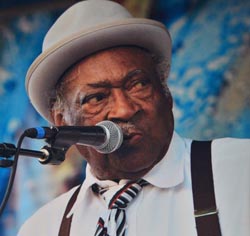
Henry Gray (1925) was born in Kenner, Louisiana, but his family soon moved to Alsen, located on the north side of Scotlandville in north Baton Rouge. Mrs. White, the community music teacher, taught him how to play the piano, blues and classical music. He was so passionate about it that sometimes he would play hooky from school to just have time to play the piano. "I was suppose to be going to school on my bicycle, but I would hide my bicycle in the bushes and go play the piano. I caught a few whippings about it, but I wanted to play the piano so bad that I wouldn't care."
Jackson: How old were you when you first started playing?
Gray: I was about twelve and now I am ninety-one.
Jackson: That is a long time to play the piano, to play the blues.
Gray: You name it and I have been there.
Gray played for the local Baptist church as he taught himself more than 20 spiritual and gospel songs. At the age of 16 he began to listen to Big Bill Broonzey and Roosevelt Sykes. He worked at the Esso Refinery for a while then joined the army and served 3 years during World War II. Gray first recorded in the early 1950s with Morris Pejeaux from Mossville, Louisiana, and J. D. Miller in Crowley before he went to Chicago and stayed for the next 40 years.
On his arrival in Chicago, Lil' Walter, who he played with in Louisiana, introduced him and he became friends with Howling Wolf and Big Maceo Merriweather, who mentored him on the techniques of blues piano. Merriweather was one of the most influential and respected blues and barrelhouse piano players in history. He had a stroke and could not play with his left hand and asked Gray to play the left hand part for him while he played the right. They played together on gigs and Gray gives him credit for teaching him how to play the left hand blues piano which is why his left hand is so strong and independent today.
Grey: That is really how I started the blues from Big Maceo. That left hand playing is really an important part.
Jackson: What makes your playing different from anybody else?
Gray: I have my own style of playing. I try not to play like nobody else, like a Muddy Waters or Jimmy Reed. I record my own style.
Jackson: Some refer to you as the two "fisted player." What does that mean?
Gray: I play with both hands, one hand playing one thing and the other playing another. And I don't just play the blues. I can play anything, blues, rock and roll, spirituals, anything.
When Gray arrived in Chicago he procured many gigs before moving into extensive work as a session musician for Chess and Vee-Jay records. Johnny Jones, who was Howlin Wolf's piano player, passed, so Wolf asked Gray to replace him and he became his core pianist for the next twelve years. Over the years, Gray has recorded and traveled the world with Howling Wolf and his band as well as doing solo gigs.
He also played and recorded with Jimmy Reed, Elmore James, Koko Taylor, Bo Diddley and many other blues bands in Chicago. The list of luminaries with whom he has performed also includes blues legends Muddy Waters and Chuck Berry. During that time, some producers did not have restrictions or exclusive contracts on musicians, so they were free agents and could perform and record with whom they wanted to.
When this interview was conducted in the summer of 2016 he was 91 and leaving for a tour in Spain the next week. Unfortunately, when he returned his home was soon devastated with several feet of water and he lost everything inside during the "100 Year Flood" in Baton Rouge and surrounding regions. Sharing his trophy/award room with me was a special treat. I saw awards, certificates, posters, and recognitions from the local Baton Rouge Blues Foundation to the National Heritage Award. It was so sad to hear that most of that was destroyed in the flood. Lately he has had some health issues, but in our last phone conversation, he was happy to report that he is still playing the blues. He owes this success to his wife and his great grandson, DeAndre Tate, who he is so proud of because he is also a musician.
Tate said that his grandfather "was my first music teacher and he has always been a constant in my life. I had a pretty good ear. . . . He was the person to help me to take what I was hearing and apply it to what I was seeing. He made that first connection for me.
DeAndre Tate went on to become a public school music teacher, a church choir director and an attorney. He did not continue in the blues field, but certainly continued his classical musical career as well as gospel music. Henry Gray is truly proud of his great grandson who now manages him and is usually near when he is performing.
Blues Lyrical Themes
While Silas Hogan and Clarence Edwards will only ever be heard performing their material, younger musicians tend to ride on the golden days of the swamp sound—the 1950s and frequently cover Slim Harpo numbers. His lazy vocal style and rolling bass are very much in evidence in the music being played in the city today. Although his early death in 1970 was a great loss to the blues world, and to the Baton Rouge bluesmen in particular, his style has been immortalized locally, and cover versions of his songs have become an integral part of any jam session, his influence on local musicians is stronger than ever. "Raining In My Heart," "Tee-Ni-Nee-Ni-Nu," and "Shake Your Hips," are all standards at any jam session, and will also be heard at gigs of musicians who do not have a sufficient repertoire of their own. Slim's influence would probably not be so apparent were he still alive today. As all his contemporaries are still musically active today, he presumably would have been too, which would have inhibited others from covering his songs to the extent that they do today. There is also the fact that the musicians, particularly of his own generation, are very proud of his music, and have honored his memory by keeping it alive. So, despite the Swamp blues losing its favorite son at an early age, his sound still reverberates around the city every night in the blues bars and clubs.
The Baton Rouge musicians are very much aware of their musical heritage, and of being a part of keeping swamp sound alive. They most perform their own material, but those who tend to rely on performing cover versions still base their repertoire on south Louisiana blues. When asked whether he had picked up any Delta influences from having spent several years playing in Mississippi, Clarence Edwards answered, "Oh no! It's not the swamp blues, you know. I know they play a lot of slide guitar, but I don't really know too much about Mississippi. We never do music by people from Mississippi." Similarly, Larry Garner, who played regularly at juke joints on Highway 61, near the Mississippi border admitted, "Mississippi, I don't know. I play Louisiana blues. I'm a Louisiana bluesman." Perhaps the reluctance to be associated with the Delta bluesman and their music that is related to the image of the poor, broken-down Mississippi bluesman "in their shotgun shanties, with the no.3 wash tub hanging' on the side," as one swamp bluesman described the popular image of a Delta bluesman. There is certainly a humorous if slightly disparaging expression on the Baton Rouge blues circuit: harp players will frequently be called up on stage to blow some "Mississippi saxophone." This is a reference to the image of the poor Mississippi bluesmen who would never be able to afford a saxophone and so will have to make do with a harmonica. Kenny Neal has a CD dedicated to the Mississippi Saxophone.
Because much of the music played is for local audiences, in effect, the musicians are often playing for themselves: Therefore, they need not tailor their material nor compromise their style to suit a particular audience. This freedom enabled the musicians, especially the younger ones, to develop their own styles, as they are not under pressure to play the same popular blues songs time and time again. Several of the musicians such as Silas Hogan and Clarence Edwards, when they were alive never played other musicians' music. Today, very seldom, Larry Garner will play any music that is not his own. Rather than playing for commercial reasons, some Baton Rouge bluesmen talk about their music as emotional release. Larry Garner explains, "Lots of times you know, whatever been bugging you that well, or that day before you come out to play, just get on the stage and talk about it. Get it out of your system, and somebody out there will relate to it, 'cause somebody will say, 'Yeah man! I know exactly what you're talking about.' It gives me a good feeling to get it off my chest. It's kind of like therapy for me, you know. You can pay a psychiatrist to sit down and tell him what's happening, or you can just stand up and tell the world. It's cheap therapy."
Garner, although dealing with the blues in a traditional manner, has approached an area in his songs over which there has been much discussion with regard to blues music--racism. With the blues being a vehicle of emotional release and personal expression, it is interesting to note that there are so few racist, or anti-white songs in the blues recorded repertoire. Many of these songs did exist, but they were deliberately hidden from record producers, folklorists, and ethnomusicologists at the time when the blues were first being documented, and as such have disappeared from the blues tradition.
However, in his song "Shutting It Down," Larry Gamer talks of the feeling of being continually worn down because of skin color, because of people's basic ignorant prejudices which can trap a man.
I get tired of all these racists. One thing I never could stand,
When someone blame their downfall, on another man.
That's why I feel like shutting it down, Feel like my life need an overhaul,
But I ain't gonna blame nobody, just get so sick and tired of it all.
The mood and message of the song are reminiscent of Robert Pete Williams, "Prisoner's Talking Blues." The style of delivery is similar in that they both talk their way through much of the song, and the content of both are about a feeling of frustration at being trapped in a system that that can't be fought. Both men are from the small town of Zachary, just north of Baton Rouge, one born in 1914, the other 1952, but it would appear the same problems traverse the decades in the deep South. "Shutting It Down" is a thought-provoking song, often heard at his performances, but he admits that he has had to cut out other songs in a similar vein because, "I was losing my audiences man. People were just, walking out on me. So, I slowed down, and I'm ashamed to have to admit that." His preaching style blues come from the influences of an uncle, who was a preacher, and taught him to play the guitar, as well as from early musical experiences in church, by playing in a quartet. Today, he still will play occasionally in his Pentecostal church.
Most Baton Rouge bluesmen are proud to be from Baton Rouge. All of those who write their own songs have at least one or more songs about the capitol city. Larry Garner, Kenny Neal, Tabby Thomas and Henry Turner have composed and recorded songs about Baton Rouge.
Juke Joints, Honky Tonks, Record Shop and Museums
Tabby's Blues Box and Heritage Hall opened in 1981 and its open night or "jam session night" featured all of the musicians who had been recorded for the Swamp Blues compilation albums, and ten years later were all still appearing there regularly. The club pulled the musicians back together again, and gave them pride in their music after years of finding it difficult to get a gig. The older musicians showcased their form of blues here and played alongside younger musicians. Nick Spitzer, who was the Louisiana State Folklorist at the time, said of Tabby Thomas, "He single-handedly managed to retain the blues culture in Baton Rouge. He is continually striving to promote the blues in the city to enable younger musicians to make use of opportunities that he himself never had."
Tabby himself tells us about the effect that the Blues Box had on the musicians: "The blues singer from here, they used to play the little cafes, they never did play no big places. They'd play to maybe fifteen, twenty people. The first place they started charging for blues was this place, right here, so before this the musicians got hardly nothing. They didn't have no place to go hang out, no place to play, until I got this place. Since I got it, lot of them been overseas, got albums out, it's really helped everybody. They all know where we are, we're a sort of a focal point."
The Blues Box was the club where the most traditional swamp sound would be heard. Among those who were instrumental in the development of the sound were, Silas Hogan, Clarence Edwards, Tabby Thomas, Rudy Richard (Slim Harpo's guitarist) and Henry Gray. Tabby was very much aware of keeping the legacy alive. "I've been listening to Silas' music for nine years, you know. I'm really payin' attention to what he is doin' cause it's very complicated and I want to keep that tradition alive. It ain't never been exploited so it should have been so I'm tryin' to do that. And some of that stuff Slim Harpo did, that's what's referred to as Swamp Blues too. I think it's good for Louisiana and it's good for the artist 'cause its represents his culture, where he's from."
Tabby's Blues Box and Heritage Hall was razed completely in 2000 in order to build an overpass to North Boulevard. The Temple Theater where many bluesmen performed was located across the street. It was saved from the wrecking ball because the Masons had it designated and included on the historical registry. Tabby was able to open up again at on Lafayette St. across from the Capitol House Hilton. He stayed there even after he suffered a stroke and was not able to play the guitar anymore, but he could still sing, and that he continued to do. The Blues Box closed after Tabby's passing in 2014. It went under new management as The Blues Room.
Teddy's Juke Joint is open for live music almost every day, but definitely from Wednesday through Sunday. This blues venue is listed among many musical destinations to visit when you are in the Baton Rouge region. Located in Zachary, which is still in East Baton Rouge Parish and only about twenty miles from Baton Rouge, Teddy's is right off Highway 61 or as blues lovers refer to it as the legendary "Blues Highway 61." It is also listed in travel guides and other national publications among the few remaining "authentic blues juke joints" as a must-see destination on the Blues Trail.
The flamboyant proprietor, Lloyd "Teddy" Johnson is a legend himself. He is not a blues performer, but a "record spinner DJ," as he prefers to be called. He decided to open Teddy's so he could stay at home and still do what he enjoyed doing, spinning records. So he expanded on the shotgun-style house he was born in, so it could include room for a bar, stage, dance floor and areas for patrons to sit as well as a towering DJ booth. He decorated it with Christmas lights, and an amalgam of vintage items from his childhood (i.e. his tricycle, toy trucks, etc.) hanging from the ceilings with an amazing collection of memorabilia from travel and musical events, including licensed plates from various states, flyers, placards, posters and many photographic images of himself, friends and musicians who have performed there as well as in other venues. In addition, he has been given instruments, usually guitars which are also hanging from the ceiling. From the time a patron walks in and before the music starts, they will immediately have a strong visual experience which is elevated if the disco-era mirror ball is on and turning and if Teddy is in one of his dressing moods with his coordinated bright colored leisure suits or one of his long capes with rings on every finger, a necklace or two as well as matching shoes. It transports you back to a James Brown flashback of the 1960s. It takes a moment to become visually acclimated to the space and to Teddy.
Local musicians as well as those who come from other states and countries love to play at Teddy's. Some international groups will play for free, just to put Teddy's, an authentic Louisiana juke joint, on their resumé of venues. Teddy celebrated the 40th anniversary in June and July 2017, featuring six blues bands and his venue continues to be one of the main venues to feature, help promote and preserve the blues in the Baton Rouge region.
Phil Brady's blues night is on Thursday and an occasional night when a bluesman is celebrated or given a benefit concert, like the one given for James Johnson, the former guitar player for Slim Harpo who had a stroke in the spring of 1917.
Club Infiniti is open for blues on Tuesday. Henry Turner's Listening Room opens occasionally and like others, usually announce it openings, or you have to call to see if someone is playing live on a particular night. So, there are still various venues to hear live blues several nights of the week in Baton Rouge. However, unless there is a special occasion, or a specific celebration, you are never quite sure who may show up to perform. In Baton Rouge, however, most of the blues events are jam sessions rather than gigs or concerts. This fact is both a reflection of the attitudes of the Baton Rouge populace, and an indication of why the music played is strongly entrenched in the swamp blues tradition.
Many other venues have closed or have ceased having live blues performances. Temple Roof located on the fourth floor of the building that housed the Temple Theater as well as meeting rooms and offices of various businesses and the Masonic Lodge, was also a hot venue at one time for blues performances. Another in South Baton Rouge was the Purple Circle on South Street. Marecos on Harding Boulevard and the Elk's Clubs were on the north side of town in Scotlandville. Byrd's Satellite Lounge across the Mississippi River also had live performances.
My experience has been that many White people, who claim to enjoy blues music, are allowing their xenophobic attitudes towards Black clubs keep them from enjoying the music that the Baton Rouge clubs have to offer. Over the years, blues bands are heard by White audiences if playing at a White club such as Phil Brady's, or The Art Bar, however, clubs such as Vibes and Visions, Club Infiniti, the Turning Point, and Estelle's are avoided because, "they're in a bad area," or for the inexplicable reason, "but it's a Black bar." All of the clubs are warm, friendly places, with hardly ever any violence, but a lot of White would-be audiences have a mental block about going to such places. These clubs, all of which hold regular jam sessions are mainly frequented by the musicians themselves, family, and friends. The blues never fully regained its popularity in the Black community after its decline during the 1960s and 1970s, and certainly the younger element of the Black community is more likely to be found at one of the many clubs, which have sprung up, and playing hip-hop music.
In terms of purchasing records and preserving the blues, Buddy Stewarts Rock Shop, Museum and Foundation on North Acadian Thruway, has been the main venue for purchasing blues recordings, concert tickets, and having live radio broadcasts. In addition, they have performances and small festivals like the Octoberfest in the parking lot of the building.
Bowie's Record Shop in Scotlandville was the main store for purchasing records and tickets for concerts in that area of Baton Rouge. It was right off Scotlandville Ave. in the center of the community. Record buyers could also occasionally see a performer there promoting one of their recent recordings especially when there is a live radio broadcast at the store.
Conclusion
Many Black church goers are still against the idea of the blues, although they are happy to have the music played, evidently it is the lyrics and traditional environments that upset them. One bluesman tells of his aunt coming up to him in church, after he had been playing his guitar and telling him, "You gotta stop hanging out in those places, if you ain't playing for the glorification of the Lord, you gonna burn in hell." This attitude is a mirror image of the Edwin Hawkins Singers, "Oh Happy Day", a sacred song, which played as pop music and therefore accepted by most people as such. Both of these instances show that the environment, in which music is received maybe indicative of how it is classified.
Environment is also a reflection of the way the blues is accepted in Baton Rouge. As one musician observed, "Those places that pull big audiences, you know, The Art Bar and such, you know, that might be where some of the music is played, but at the juke joints and such, this is where the music is made."
Notes
All interview excerpts were taken from interviews conducted by the author unless otherwise noted.
Bibliography
Ball, Kathy. 1999. "Henry Gray." Summer Cultural Arts Series Program Booklet, Lafayette, Louisiana.
Barlow, William. 1989. "Looking Up At Down:" The Emergence of a Blues Culture. Philadelphia: Temple University Press.
Beyer, Jimmy.1980. Baton Rouge Blues. The Arts and Humanities Council of Greater Baton Rouge, Baton Rouge, Louisiana.
Brady, Phil. 2002. "Raful Neal: Big Bad Bayou Daddy," Big City Blues. Vol. 8, No. 2 (April-May): 12-14.
Broven, John. 1987. South to Louisiana: The Music of the Cajun Bayous. Gretna, LA: Pelican Publishing Company.
Ellison, Mary. 1989. Extensions of the Blues. London: John Calder Press. London. 1989.
Govenar, Alan. 1988. Meeting The Blues. Dallas, TX: Taylor Publishing Company.
Jackson, Joyce. 2004-2005. "Raful Neal: The Blues Legend Lives On," Refreshen Louisiana. Vol 1 (December-January): 9.
_____1999. "Blues Evolution." Summer Cultural Arts Series Program Booklet.
Manning, Marable. 1984. Race, Reform and Rebellion: The Second Reconstruction in Black America, 1945-82. Jackson: University Press of Mississippi.
Oliver, Paul. 1984. Blues off the Record. Tunbridge Wells, KT: The Baton Press.
Oster, Harry. 1969. Living Country Blues. Detroit, MI: Folklore Associates.
Interviews
Alexander, Stefanie. 2017. Personal Interview. Baton Rouge, Louisiana. January 24.
Anthony, Sidney. 2016. Personal Interview. Zachary, Louisiana. July 2.
Carney, Lujames "L.C." 2017. Personal Interview. Zachary, Louisiana. January 17.
Gray, Henry. 2016. Personal Interview. Baton Rouge, Louisiana. July 8.
Hall, Robert "Joe". 2017. Personal Interview. Baton Rouge, Louisiana. January 25.
Hatcher, Patricia "Pat" Lunnete. 2016. Personal Interview. Baton Rouge, Louisiana. August 23.
Hogan, Silas. 1986. Personal Interview. Baton Rouge, Louisiana.
Hogan, Samuel. 2017. Personal Interview. Baton Rouge, Louisiana. February 9.
Jackson, April. 2017. Personal Interview. Baton Rouge, Louisiana. January 17.
Johnson, Lloyd "Teddy". 2017. Personal Interview. Zachary, Louisiana. January 31.
Joyner, Sam. 2016. Personal Interview. Baton Rouge, Louisiana. July 2.
King, Chris Thomas. 2016. Personal Interview. Prairieville, Louisiana. March 23.
Knox, Harvey. 2015. Personal Interview. Baton Rouge, Louisiana. September 22
Neal, Kenny. 2016. Personal Interview. Baton Rouge, Louisiana. August 16.
Neal, Raful. 2016. Personal Interview. Baton Rouge, Louisiana. July 8.
Porter, Mamie. 2017. Personal Interview. Baton Rouge, Louisiana. January 27.
Porter, McKinley "Smokehouse". 2017. Personal Interview. Baton Rouge, Louisiana. January 27.
Stewart, Phillipa. 2015. Personal Interview. Baton Rouge, Louisiana. November 11.
Tate, DeAndre. 2016. Personal Interview. Baton Rouge, Louisiana. July 14.
Thomas, Tabby. 1986. Personal Interview. Baton Rouge.
Turner, Jr., Henry. 2017. Personal Interview. Baton Rouge, Louisiana. January 7.



